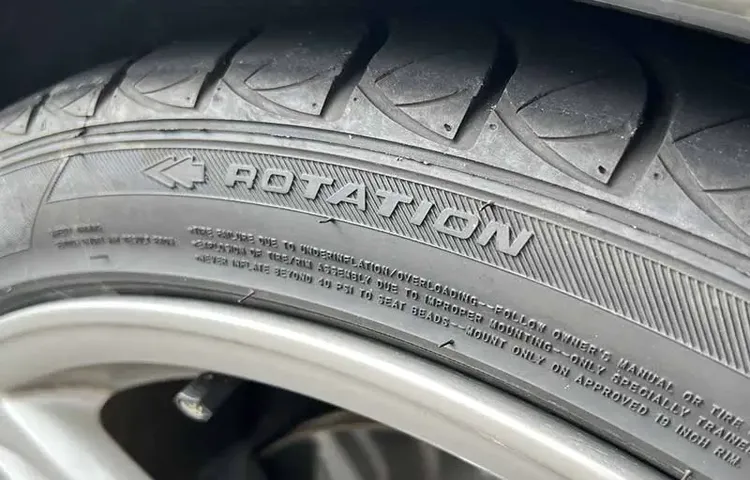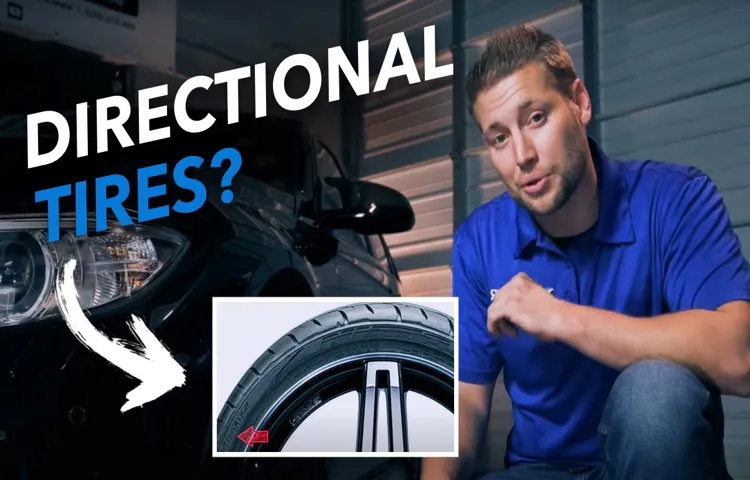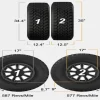Have you ever wondered what would happen if you put a directional tire on backwards? Well, the answer is not as simple as you might think. Directional tires are designed to perform optimally in one specific direction, with tread patterns that channel water away from the tire to improve grip on wet surfaces. Installing them backwards could lead to some serious performance issues.
It may not be immediately noticeable, but a backwards directional tire will have reduced handling and braking capabilities, poor traction on wet surfaces, and increased road noise. This is because the tire’s tread pattern is designed to work in one direction only. Putting it on backwards disrupts the flow of water away from the tire, reducing its ability to grip the road and potentially causing hydroplaning.
Furthermore, it’s important to note that directional tires cannot be rotated from one side to another, as this would reverse the direction of the tire’s pattern. This means that you must purchase a second set of directional tires if you want to swap them out between seasons. In short, putting a directional tire on backwards will negatively impact your vehicle’s handling and performance.
Always ensure that you are installing your tires correctly and understand the specifications of your chosen tire type. The safety of yourself and others on the road depends on it.
Table of Contents
Understanding Directional Tires
Directional tires are designed to rotate in a specific direction. Putting them on backwards can have serious consequences. First off, it can negatively affect the performance of your vehicle.
The tire’s design can provide better traction in wet weather conditions, but it only works if the tire is rolling the right way. If it’s installed incorrectly, the grooves will be pointing in the wrong direction, reducing the amount of grip on the road, leading to poor handling, and longer breaking distances. More importantly, it can also be a safety hazard.
Directional tires are designed to expel water from under the tread and improve road contact, but when installed backward, the grooves will push water towards the center of the tire, leading to hydroplaning and loss of control. So it is essential to be careful when installing these types of tires. Make sure you double-check your installation to avoid putting your vehicle and yourself at risk.
How Directional Treads Are Designed
Directional treads on tires are designed to enhance the performance of the vehicle in various conditions. The tread on the tire is designed to rotate in a specific direction, providing better traction in certain conditions like wet or snowy roads. The design of the directional tread is like that of an arrow pointing in the direction of travel.
It is carefully planned to provide maximum grip and minimize hydroplaning by evacuating water efficiently. The tread block is also designed to reduce road noise, making the ride more comfortable for the driver. The rubber compound used in the tire is also carefully selected to ensure it is durable and long-lasting.
Directional tires are preferred by drivers who want better handling and control when driving, especially in wet or snowy weather conditions. They are a great choice for sports cars and high-performance vehicles, as well as SUVs and trucks that need to tackle off-road conditions. If you are looking to upgrade your tires, consider getting directional tires for a safer and more comfortable ride.

Benefits of Using Directional Tires As Intended
Directional tires are specifically designed with a V-shaped tread pattern that helps in channeling water away from the tire, thereby improving its grip on the road. While these tires were initially designed for high-performance vehicles, they have since become a popular choice for all types of vehicles due to their many benefits. However, to reap these benefits, it’s important to use directional tires as intended.
For example, if you install them on your vehicle facing the wrong way, you’ll end up reversing their intended purpose and risk reducing their overall effectiveness. Using directional tires as intended helps to ensure maximum performance, longer tire life, and better handling, especially in wet weather conditions. Other benefits of using directional tires include reduced road noise, improved fuel efficiency, and a quieter, smoother ride.
With proper use, directional tires can help improve your driving experience, safety, and overall vehicle performance.
The Effects Of Installing Directional Tires In Reverse
If you ever happen to put a directional tire on backwards, you’ll be in for some serious trouble. Directional tires, as the name suggests, are specifically designed to rotate in a specific direction for maximum performance, handling, and safety. They are engineered with tread patterns that are optimized for specific conditions like wet roads.
As a result, mounting such a tire in reverse would mean dislodging the tread pattern from its intended direction, which could adversely affect the tire’s handling, stability, and traction. That’s because the tread’s V-shape grooves are designed to push water away from the center of the tire and improve grip, so positioning them the wrong way would do the opposite, leading to hydroplaning, skidding, and loss of control. Therefore, it’s important to always double-check that the tire’s direction is correct before installing it.
Changes in Traction and Handling
Installing directional tires in reverse can significantly impact the traction and handling of your vehicle. Directional tires are designed to channel water away from the center of the tire, allowing for better grip on wet roads. However, installing them in reverse can reverse this effect, forcing water towards the center of the tire and reducing traction.
Additionally, installing directional tires in reverse can cause the tire to wear unevenly and decrease the overall lifespan of the tire. It’s important to follow the manufacturer’s instructions and ensure that directional tires are installed properly to avoid compromising the safety and performance of your vehicle. So, if you’re considering installing directional tires, make sure to get it done by a professional who can help you follow the correct installation procedures.
Remember, a little attention to detail goes a long way in ensuring the safety of you and your loved ones on the road.
Increased Risk of Hydroplaning and Aquaplaning
Installing directional tires in reverse can cause an increased risk of hydroplaning and aquaplaning. This is because directional tires are designed to disperse water in a specific pattern, allowing for improved traction on wet roads. When installed in reverse, the tire’s tread pattern is going against the direction of the water flow during wet conditions, leading to reduced traction and increased risk of hydroplaning.
Hydroplaning occurs when a vehicle’s tires lose contact with the road surface due to water buildup, while aquaplaning is when a vehicle glides on top of a layer of water. Both can be extremely dangerous, causing the driver to lose control of the vehicle and potentially lead to accidents. Therefore, it’s crucial to ensure that directional tires are installed correctly to maintain optimal performance and safety on the road.
Reduced Efficiency and Performance
If you’re thinking of turning your directional tires around and installing them in reverse, you may want to reconsider. Doing so can lead to reduced efficiency and performance for your vehicle. Directional tires are designed to perform at their best when they’re rolling in a specific direction, with treads that are angled and shaped to provide optimal traction and handling.
When you install them in reverse, the treads won’t function properly, leading to reduced traction, a decrease in handling and stability, and an overall reduction in performance. Think of it like trying to run a race in flip flops – it’s not going to provide the same level of performance as running in proper running shoes. So, keep those directional tires rolling in the right direction for the best performance and safest ride.
Tips on Maintaining Your Directional Tires
If you put a directional tire on backwards, it can have severe consequences on your car’s handling and safety. Directional tires have a specific tread pattern that is designed to provide maximum traction and stability under specific driving conditions. If they are installed incorrectly, you will compromise your car’s ability to grip the road properly, especially in wet conditions.
The tire will also generate more noise, and you’ll feel a vibration in the steering wheel that will affect your driving comfort. Therefore, it is crucial to ensure directional tires are installed by an experienced professional who can check their rotation and position. Properly maintaining your directional tires involves regular tire rotations and avoiding hitting curbs or driving over rough terrain that could cause damage.
Regular inspections of tire pressure and tread depth will also help prevent accidents on the road.
Regularly Check The Tread Pattern and Rotation
If you own a car, it’s important to keep it well-maintained not just for the safety of the passengers but also to keep it running smoothly. If you have directional tires, there are a few things you should keep in mind with regards to tire maintenance. Firstly, you should regularly check the tread pattern on your tires.
You can use the penny test to determine the level of tread remaining on your tires. If the tread has worn down too much, it can lead to unsafe driving conditions, particularly in wet weather. Another important factor to keep in mind is tire rotation.
Directional tires can only be rotated in one direction, so it’s important to follow the manufacturer’s recommendations for tire rotation to ensure even wear and tear. By keeping an eye on your tread pattern and tire rotation, you’ll be able to prolong the life of your tires, and keep your car driving safely on the road.
Avoid Mix and Matching Tires of Different Types
Directional tires are a popular choice among drivers due to their improved handling and stability on wet roads. However, maintaining them properly is essential to get the most out of your investment. One crucial thing to keep in mind is to avoid mix-and-matching tires of different types, as this can lead to uneven wear and affect your car’s handling.
It’s also vital to have your directional tires rotated regularly to ensure even tread wear across all tires. This will not only extend the life of your tires but also provide a smoother ride. Finally, make sure you check your tire pressure regularly to ensure optimal performance and safety on the road.
By following these tips, you can keep your directional tires in top condition and enjoy a safe and comfortable driving experience all year round.
Conclusion
Putting a directional tire on backwards is like trying to wear shoes on the wrong feet – you’re bound to trip and stumble. Not only will it lead to poor handling and diminished grip on the road, but it may also cause unwanted noise and vibrations. So, unless you’re going for a bumpy and noisy ride, make sure to always double-check the direction of your tires before hitting the road!”
FAQs
What are directional tires?
Directional tires have a specific tread pattern that is designed to only rotate in one direction for optimal performance and handling.
How do you identify the proper direction for directional tires?
Look for arrows on the sidewall of the tire indicating the direction of rotation. Mount the tire so that the arrows point in the correct direction.
What happens if you mount a directional tire backwards?
Mounting a directional tire backwards will result in reduced traction, handling, and performance. This is because the tread pattern is designed to operate in one specific direction.
Can you reverse the direction of a directional tire?
No, directional tires cannot be reversed. They are designed to only roll in one specific direction.
Should you rotate directional tires?
Yes, directional tires can be rotated but only from front-to-back or back-to-front. They cannot be crossed over as this will reverse the direction of rotation.
Are all tires directional?
No, not all tires are directional. There are also asymmetric and non-directional tires.
What’s the difference between directional and asymmetric tires?
Directional tires have a V-shaped tread pattern that can only be mounted in one specific direction, while asymmetric tires have a tread pattern that varies across the tire and can be mounted in either direction.


